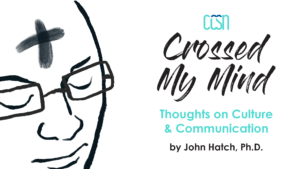Crossed My Mind: Thoughts on Culture and Communication
By John Hatch, Ph.D.
Eastern University (retired)
CCSN Senior Fellow
Column Description: As Christians, we are called to have the mind of Christ. This goes against the grain of our social and cultural conditioning. We seek personal or political advancement; Christ seeks the lost and the least. We grasp for cultural ascendency; Christ descends to the cross of love. This column is dedicated to thinking about culture and communication under the sign of the cross.
October 2022 / August-September 2022 / June-July 2022 / January 2022 / December 2021 / October-November 2021
OCTOBER 2022
Frederick Buechner and Telling the Truth
The world recently learned of the passing of Frederick Buechner. His was a long and productive life. Authoring nearly 40 books, Buechner was a master at novels (including a Pulitzer Prize finalist), memoirs, popular theology, and sermons.
As tributes to Buechner’s legacy streamed through my newsfeed, I was prompted to look back at Telling the Truth: The Gospel as Tragedy, Comedy, and Fairy Tale. The last time I had read this slim volume was during my dissertation work in graduate school, two decades ago. Jeffrey Munroe aptly characterizes the book as “funny and wise and contemporary and timeless.”[1] As it happens, Telling the Truth has striking relevance to topics explored in this column.
In my August column, I examined the social justice debate in light of the fullness of Christ and his kingdom—where “Mercy and truth have met together” and “Justice and peace have kissed” (Psalm 85:10, TLB). There are strong parallels between Buechner’s account of gospel truth and the biblical picture of shalom captured in this verse. In God’s kingdom, truth embraces justice, peace, and grace/mercy. In Buechner’s depiction, gospel truth not only faces the reality of flawed human beings, it also reveals the tragedy, comedy, and fairy tale of our existence under the gracious providence of God. These two pictures are connected. Let’s start with Buechner’s account of gospel truth.
Buechner conveys his thesis thus: “It is possible to think of the Gospel and our preaching of it as, above all and at no matter what risk, a speaking of the truth about the way things are.”[2] This boils down to facing reality: “Truth simply is, and is what it is, the good with the bad, the joy with the despair, the presence and absence of God, the swollen eye, the bird pecking the cobbles for crumbs.”[3]
Although this may sound simple, the reality to which the gospel attests is living and multi-layered; it runs deep. For this reason, Buechner writes, “Before it is a word, the Gospel that is truth is silence, a pregnant silence in its ninth month.”[4] As an example, he cites Christ’s silence before Pilate. Although Jesus came to “testify to the truth,”[5] the truth of His identity and mission is more profound, more foundational, than the political categories that motivated Pilate’s questioning. Thus, for the most part, He kept silent.
Not only is Christ’s truth deeper than words; it is wider (and fuller) than the facile realism that we, like Pilate, often settle for: a cynical materialism that marginalizes God and compromises integrity to gain worldly power, reputation, or security. The gospel instead keeps faith with the reality that humans are moral beings, created in the image of God for eternal goodness—though we fall short in this calling. Buechner unpacks the implications of this truth:
“The Gospel is bad news before it is good news. It is the news that man [sic] is a sinner, to use the old word, that he is evil in the imagination of his heart . . . That is the tragedy. But it is also the news that he is loved anyway, cherished, forgiven, bleeding to be sure, but also bled for. That is the comedy. And yet, so what . . . when the very mark and substance of his sin . . . is that he keeps turning down the love and forgiveness because he either doesn’t believe them or doesn’t want them or just doesn’t give a damn? In answer, the news of the Gospel is that extraordinary things happen to him just as in fairy tales extraordinary things happen,”[6] because “for God all things are possible. That is the fairy tale. All together they are the truth.”[7]
Across its four chapters, Telling the Truth unpacks these facets of gospel truth: realism, tragedy, comedy, and fairy tale. Buechner’s observations on each of them are witty, insightful, and provocative. But what does this have to do with shalom as the joining of truth, justice, peace, and mercy in the kingdom of God?
In short, each of the four literary frames identified by Buechner is oriented around one of the values from Psalm 85:10.
First, the gospel is a realistic account because it faces truth even when the truth doesn’t neatly fit into a moral box. Like Jesus, Buechner acknowledges that those who speak for God are not super-saints but flawed and vulnerable human beings, and that sickness and suffering can strike anyone, regardless of their moral uprightness or lack thereof. Stuff happens. More often than we care to admit, we don’t understand why.
At the same time, the gospel is tragedy because human societies and individuals violate God’s justice, setting in motion the inevitable negative consequences of selfish disregard for our creator and others who bear God’s image. We are called to account for our hubris. What is more, even the Son of God cannot escape the bitter cup of tragedy: the only way to get through to us and make us just is by drinking down the poison of our corruption. God incarnate is “pierced for our transgressions” and “crushed for our iniquities” on a cross of execution (Isaiah 53:5, NIV).
Fortunately, the gospel is comedy as well: beneath our folly, our blindness, our masks, God sees His image in us, feels our pain, and wants us to be at peace with Him, ourselves, and others. Donning the ultimate comic disguise, He enters the world as the son (apparently) of a blue-collar worker from a backwater town. Although Jesus of Nazareth has no credentials for rabbinic ministry, he demonstrates greater spiritual authority than the religious professionals. His ministry breaks through ironclad divisions, violates taboos, and embraces outcasts. To their joy and hilarity, Christ eats with sinners, touches lepers, fraternizes with those who know themselves to be fools, and turns the social/religious hierarchy upside-down. His blood even makes peace between Jew and Gentile.[8]
Finally, the gospel is fairy tale because Christ is full of divine grace and mercy, exercising His infinite power to free us from the bonds of sin and give us a new lease on life. Miracles happen wherever Jesus of Nazareth goes: “the blind see, the lame walk, the lepers are cleansed, the deaf hear, the dead are raised,” and sinners are forgiven (Luke 7:22, NKJV). His disciples marvel that His authority knows no bounds: “Even the winds and the waves obey him!” (Matthew 8:27b, NIV). Death itself cannot keep him bound: Christ breaks out and lets his resurrection loose on the world, starting with his stunned followers. Ever since, we are called to be transformed by this truthful, tragicomic fairy tale, to believe and express and embody it to the ends of the earth.
That is the fullness of the gospel. It restores truth, justice, peace, and grace together. It seamlessly combines realism, tragedy, comedy, and fairy tale. “All together they are the truth,” Buechner says.
If we let the truth of the gospel work on us fully, it transforms not only our relationship with God and our neighbor, but how we look at the world and its problems—whether poverty or politics, identity or culture, nationalism or globalism, racism or reconciliation.
But when we reduce its multi-faceted richness to a one-dimensional dichotomy that serves our argument or our tribe, we fail the truth and betray the gospel. This applies not only to the preachers delivering sermons (Buechner’s focus), but also pundits, professors, or preachers presenting cultural problems and solutions.
With this in mind, my next few columns will consider some important recent books that address one of our contemporary challenges: race relations. We will consider where these writers do justice to truth; where they miss the fullness of truth modeled in the gospel; and—in some cases—where they do it violence.
Notes
[1] Jeffrey Munroe, Reading Buechner: Exploring the Work of a Master Memoirist, Novelist, Theologian, and Preacher (Westmont, IL: IVP Books, 2019), 2.
[2] Frederick Buechner, Telling the Truth: The Gospel as Tragedy, Comedy, and Fairy Tale (HarperSanFrancisco, 1977), 7.
[3] Buechner, Telling the Truth, 16.
[4] Buechner, Telling the Truth, 16.
[5] From John 18:37, New International Version.
[6] Buechner, Telling the Truth, 7.
[7] Buechner, Telling the Truth, 8.
[8] Ephesians 2:11-19.


